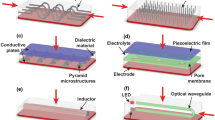Abstract
Integration of tactile afferent signals with motor commands is crucial for the performance of purposeful movements such as during manipulation of an object in the hand. To study the somatotopic organization of sensorimotor integration we applied electrical peripheral conditioning stimuli to a digit located near (homotopic stimulation) or distant from (heterotopic stimulation) relaxed or isometrically contracted intrinsic hand muscles at variable time intervals prior to transcranial magnetic stimulation (TMS). Cutaneous stimulation has previously been shown to modulate the amplitude of the motor evoked potential (MEP) and to shorten the duration of the silent period (SP) evoked by TMS. In relaxed target muscles the time-dependent modulation of TMS-evoked motor responses by homotopic conditioning stimulation differed from modulation by heterotopic stimulation. Similar differences in the modulation pattern evoked by homotopic and heterotopic conditioning stimulation were observed for two distinct target muscles of the hand (abductor digiti minimi, abductor pollicis brevis muscle). Differences in modulation were maximal when the conditioning stimulation was applied 25–30 ms and 150–200 ms prior to TMS. Comparison of the modulation of the amplitudes of MEPs evoked by transcranial electrical stimulation (TES) and the modulation of those evoked by TMS suggests that differences between homotopic and heterotopic stimulation originate subcortically at 25- to 30-ms and, at least partially, cortically at 150- to 200-ms interstimulus intervals. In isometrically contracted intrinsic hand muscles the degree to which the SP was shortened reflected the location and the timing of the conditioning stimulus. Shortening was maximal when the conditioning stimulus was applied nearest to the contracted target muscle and 20 ms prior to the test stimulus. In contrast to the SP duration, the MEP size in voluntarily contracted target muscles was unaffected by the location of the conditioning stimulus. The somatotopic gradient of SP shortening was abolished when the two target muscles were simultaneously activated isometrically. Together, our findings suggest that somatotopy of input-output relationships is implemented at both a spinal and a cortical level in the human central nervous system and may also depend on the motor task involved.
Similar content being viewed by others
Author information
Authors and Affiliations
Additional information
Received: 25 August 1998 / Accepted: 11 June 1999
Rights and permissions
About this article
Cite this article
Classen, J., Steinfelder, B., Liepert, J. et al. Cutaneomotor integration in humans is somatotopically organized at various levels of the nervous system and is task dependent. Exp Brain Res 130, 48–59 (2000). https://doi.org/10.1007/s002210050005
Issue Date:
DOI: https://doi.org/10.1007/s002210050005




